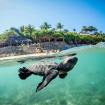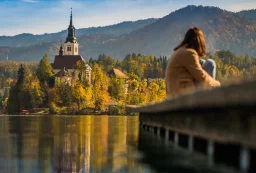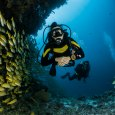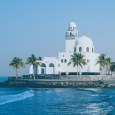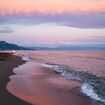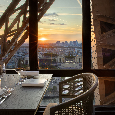
Kazakhstan. What images does that conjure up? Ancient history, poor economy, and the Silk Road?
Well, be prepared for some surprises. Unlike the other ‘stans’, Kazakhstan is wealthy, modern and safe. It’s where tulips and apples come from and it’s the home of space exploration. The largest landlocked country in the world and the ninth largest overall, it’s also home to 17 million people and great wildlife, including snow leopards.

Perhaps the first surprise is getting there. Air Astana, the national airline is 49% owned by British Aerospace and has been named “Best Airline in India and Central Asia” for the last six years; the service is top class. It offers direct flights from a number of European countries and is headed up by Englishman Peter Foster who has the OBE for his efforts.
Kazakhstan’s two major cities are traditional Almaty, the former capital, and purpose-built Astana (recently re-named Nur-Sultan) the current capital. The two cities could not be more contrasting.
Kazakhstan gained independence from the USSR in 1991, and Almaty was the capital until 1997. It’s the country’s largest city and has numerous restaurants, international hotels and nightlife. Food in the city’s restaurants is excellent, and although menus in English may not be universally available, all have pictures of the dishes so you can see what you are ordering. The country is wealthy and tourism is not a big industry. Visitors are treated with great courtesy and sometimes with polite curiosity. A reminder of how safe this country is can be seen from people standing by the roadside hitching rides from perfect strangers.
"Surprisingly, as the world’s largest landlocked country and ninth largest overall, Kazakhstan stands apart from the other ‘stans’ as its abundance of oil reserves and numerous other valuable minerals mean it is a country of wealth, modernity and safety. "
Centre stage for visitors is Panfilov Park, home to the magnificent Russian Orthodox Zenkov Cathedral. The largest wooden cathedral in the world, it was traditionally built without nails. The interior is just as impressive as the exterior, with magnificently painted screens. The park itself is dedicated to soldiers lost in the two world wars, and one memorial contains part of the old Berlin Wall. Another surprise is the nearby Rakhat chocolate factory, which produces a top-quality product range enjoyed internationally, especially in China and Russia.

Almaty is close to a mountain range that divides it from China. The Medeu dam, basically a wall of rocks and earth, was built to protect the city from major mudslides. Next to it sits the Medeu skating rink, at over 5,500ft it’s the world’s highest. The conditions are so good that around two hundred world records have been broken there. The surrounding wooded hills make it a winter sun trap and the temperature can reach fifteen degrees. Girls skate in bikinis and it’s where many boys meet their future wives; speed skating meets speed dating! The adjacent winter sports resort of Shymbulak has run from 10,500ft. Prince Harry has skied there, and it narrowly lost out to Beijing to host the 2022 Winter Olympics.

It’s a ninety-minute flight from the old capital, Almaty, to the new capital Nur-Sultan which, like Brasilia, is purpose-built. CNN described it as the world’s weirdest capital, due to the unique architecture, but perhaps ‘stunning’ would be a better description.
British architect Norman Foster is responsible for some of its amazing structures, which include the Khan Shatyr shopping mall. Officially the world’s largest tent, its design could be described as a lop-sided cone. There are three levels of shops, mostly familiar brands, but on the fourth floor is the indoor Sky Beach Club, complete with water, sun-beds and a beach made with sand from the Maldives. How bizarre that for around £25 you can have a day at the beach in the world’s largest landlocked country!

Norman Foster also designed the pyramid-shaped Palace of Peace and Reconciliation. Because the temperature in Nur-Sultan ranges from 30 degrees in summer to minus 40 degrees in winter, two sides of the pyramid are on roller bearings to allow for contraction and expansion.
The imposing classical-looking Presidential Palace resembles a cross between the White House and a mosque and is in total contrast to the neighbouring ultra-modern concert hall, a striking and unique turquoise structure. The city is dominated by Baiterek, a 300ft high tower vaguely reminiscent of a football trophy. It offers great views from the top where the geometric design of the city can best be appreciated. Nearby is an art gallery resembling a huge doggy bowl and the opera house, built in the style of a Roman temple.
The ultra-modern National Museum has a Gold Room with a magnificent collection of over four thousand items dating back to 4th and 5th centuries BC, all in perfect condition. It looks like a Fifth Avenue jewellers. There’s even a stunning gold suit of armour.

Perhaps less well known and some distance from these two cities is Baikonur, the world’s busiest, largest and oldest cosmodrome. It’s from there that the first satellite, Sputnik, was launched and the first man in space, Yuri Gagarin. It is still a hive of activity today, launching satellites and ferrying cargo and astronauts to the International Space Station.
Kazakhstan is not what most people imagine, and it has hardly been discovered by western tourists, a few of whom pass through on a silk road itinerary. They are missing an amazing and friendly country that has so much to offer those who spend time discovering its unique charms.

Kazakhstan is probably not what you imagined and has so much to offer visitors, yet it has hardly been discovered by western tourists who stick to the silk road itinerary.
